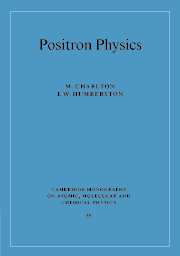Book contents
3 - Elastic scattering
Published online by Cambridge University Press: 15 August 2009
Summary
Introduction
In this chapter we describe the elastic scattering of positrons by atoms and molecules over the kinetic energy range from zero to several keV, concentrating mainly on the angle-integrated cross section, σel. However, reference is also made to differential cross sections, dσel/dΩ, which have recently become amenable to experimental measurement using crossed gas and positron beams.
Particular attention is given to relatively simple targets, e.g. atomic hydrogen, helium, the alkali and heavier rare gas atoms and small molecules, and some comparisons are made with the corresponding data for electron impact. This again highlights the differences and similarities in the scattering properties of the two projectiles, which have already been mentioned in subsection 1.6.1 and in Chapter 2.
At energies below the lowest inelastic threshold, elastic scattering is the only open channel (except for electron–positron annihilation, which is always possible but which usually has a negligibly small cross section). For all atoms, the lowest inelastic threshold is that for positronium formation, at an energy EPs, but for the alkali atoms positronium formation is possible even at zero incident energy. Molecular targets usually have thresholds for rotational and vibrational excitation at energies below EPs, although the elastic scattering cross section is nevertheless expected to dominate over the cross sections for these inelastic channels.
We continue this chapter with a detailed description of the theoretical models applied to the elastic scattering of positrons by atoms and molecules.
- Type
- Chapter
- Information
- Positron Physics , pp. 94 - 149Publisher: Cambridge University PressPrint publication year: 2000

